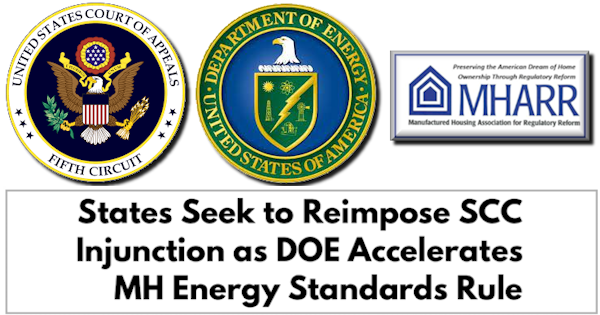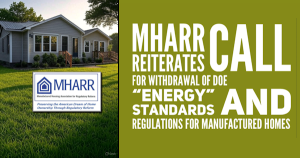States Seek to Reimpose SCC Injunction as DOE Accelerates MH Energy Standards Rule

APRIL 7, 2022
RE: STATES SEEK TO REIMPOSE SCC INJUNCTION AS
DOE ACCELERATES MH ENERGY STANDARDS RULE
The ten states that obtained a nationwide federal district court injunction against the utilization of the “Social Cost of Carbon” (SCC) metric in connection with federal rulemaking proceedings – including the pending U.S. Department of Energy (DOE) rulemaking for manufactured housing energy standards – have filed a motion seeking a re-hearing by the entire Fifth Circuit U.S. Court of Appeals after a three-judge panel of that court stayed the original injunction in a ruling issued on March 16, 2022. This request for en banc review could result in the re-imposition of the original injunction pending the full appeals process. Significantly, DOE, in filings already submitted to the Fifth Circuit, has conceded that the DOE manufactured housing energy rule would be among the proceedings stayed under the district court’s original injunction.
Meanwhile, DOE, obviously seeking to take advantage of the potentially brief window of opportunity provided by the current stay of the district court’s original injunction, has issued a “final” Environmental Impact Statement (EIS) in connection with the proposed manufactured housing energy standards rule.
The nearly 400-page final EIS which, according to DOE, includes information presented in the previously-published draft EIS, “as well as further analyses developed in response to public comments on the draft EIS” was emailed by DOE to select recipients (and posted to DOE’s internet website) on April 5, 2022, just 36 days after the February 28, 2022 conclusion of the public comment period for the draft EIS. In slightly more than one month, therefore, DOE has supposedly analyzed and addressed, in the final EIS, the 150-plus comments filed in the EIS rulemaking docket, including comments filed by MHARR, which document the utter and complete invalidity of the draft EIS and its various “findings” and assumptions.
More likely, though, as MHARR anticipated and expects to confirm upon a full and comprehensive review of the “final” EIS, is that DOE has unlawfully accelerated publication of the final EIS – without fully and properly addressing the extremely serious issues raised by MHARR and other opponents, as affirmatively required by applicable statute – in order to complete the EIS process and lay the groundwork for the rapid publication of a final manufactured housing energy standards rule before the window of opportunity provided by the Fifth Circuit panel’s decision staying the nationwide SCC injunction closes.
Given its potentially significant impact, MHARR has – and will continue to – closely monitor the Fifth Circuit proceeding in relation to DOE’s destructive manufactured housing energy rule, as part of a carefully-developed approach to this matter.
APRIL 7, 2022
RE: STATES SEEK TO REIMPOSE SCC INJUNCTION AS
DOE ACCELERATES MH ENERGY STANDARDS RULE
The ten states that obtained a nationwide federal district court injunction against the utilization of the “Social Cost of Carbon” (SCC) metric in connection with federal rulemaking proceedings – including the pending U.S. Department of Energy (DOE) rulemaking for manufactured housing energy standards – have filed a motion seeking a re-hearing by the entire Fifth Circuit U.S. Court of Appeals after a three-judge panel of that court stayed the original injunction in a ruling issued on March 16, 2022. This request for en banc review could result in the re-imposition of the original injunction pending the full appeals process. Significantly, DOE, in filings already submitted to the Fifth Circuit, has conceded that the DOE manufactured housing energy rule would be among the proceedings stayed under the district court’s original injunction.
Meanwhile, DOE, obviously seeking to take advantage of the potentially brief window of opportunity provided by the current stay of the district court’s original injunction, has issued a “final” Environmental Impact Statement (EIS) in connection with the proposed manufactured housing energy standards rule.
The nearly 400-page final EIS which, according to DOE, includes information presented in the previously-published draft EIS, “as well as further analyses developed in response to public comments on the draft EIS” was emailed by DOE to select recipients (and posted to DOE’s internet website) on April 5, 2022, just 36 days after the February 28, 2022 conclusion of the public comment period for the draft EIS. In slightly more than one month, therefore, DOE has supposedly analyzed and addressed, in the final EIS, the 150-plus comments filed in the EIS rulemaking docket, including comments filed by MHARR, which document the utter and complete invalidity of the draft EIS and its various “findings” and assumptions.
More likely, though, as MHARR anticipated and expects to confirm upon a full and comprehensive review of the “final” EIS, is that DOE has unlawfully accelerated publication of the final EIS – without fully and properly addressing the extremely serious issues raised by MHARR and other opponents, as affirmatively required by applicable statute – in order to complete the EIS process and lay the groundwork for the rapid publication of a final manufactured housing energy standards rule before the window of opportunity provided by the Fifth Circuit panel’s decision staying the nationwide SCC injunction closes.
Given its potentially significant impact, MHARR has – and will continue to – closely monitor the Fifth Circuit proceeding in relation to DOE’s destructive manufactured housing energy rule, as part of a carefully-developed approach to this matter.












